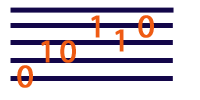WebAudio and WebMIDI Experiments
Support for the Web Audio API is not the same in all browsers. If you have trouble playing the examples, try using Chrome.
Attack Decay Envelope using AudioGain
Use an AudioGainNode to smoothly raise and lower the volume of a sound.
Roll mouse over the paragraphs below to start and stop sound.
Mode=1, linearRampToValueAtTime() for attack and decay
Mode=2, linearRampToValueAtTime() up and down several times, linear down
Mode=3, linearRampToValueAtTime() for attack, exponentialRampToValueAtTime() for decay, setTargetValueAtTime() for release
Mode=4, setTargetValueAtTime() for attack and release
Look in the code below to see how the test modes are applied. Example uses "webaudio_tools.js".
// Example showing how to produce a tone using Web Audio API.
// Load the file webaudio_tools.js before loading this file.
var jsProcessor = 0;
// Variables used to control the tone generator.
var phase = 0.0;
var baseFrequency = 440.0;
var kSampleRate = 44100.0;
var kBufferSIze = 1024; // must be power of 2
var phaseIncrement = 2.0 * Math.PI * baseFrequency / kSampleRate;
var kTwoPi = 2.0 * Math.PI;
var soundEnabled = false;
var gainNode;
// Create a JavaScriptNode and a gainNode.
function initAudio()
{
// Use audioContext from webaudio_tools.js
if (audioContext)
{
// This AudioNode will generate a tone.
// Node has zero inputs and one output.
jsProcessor = audioContext.createScriptProcessor(kBufferSIze, 0, 1);
jsProcessor.onaudioprocess = process;
gainNode = audioContext.createGain();
// Connect our process to the mixer of the audioContext.
jsProcessor.connect(gainNode);
gainNode.connect(audioContext.destination);
gainNode.gain.value = 0.0;
}
}
// This function will be called repeatedly to fill an audio buffer and
// generate sound. WebAudio now has built in oscillators so there are
// easier ways to generate a sine wave. But this shows you how to make
// custom waveforms.
function process(event)
{
// Get array associated with the output port.
var outputArray = event.outputBuffer.getChannelData(0);
var n = outputArray.length;
for (var i = 0; i < n; ++i)
{
// Generate a sine wave.
var sample = Math.sin(phase);
outputArray[i] = sample * 0.6;
// Increment and wrap phase.
phase += phaseIncrement;
if (phase > kTwoPi)
{
phase -= kTwoPi;
}
}
}
// Experiment with various ways of applying an envelope.
function startTone( mode )
{
var now = audioContext.currentTime;
gainNode.gain.cancelScheduledValues( now );
// Anchor beginning of ramp at current value.
gainNode.gain.setValueAtTime(gainNode.gain.value, now);
if( mode == 1 )
{
// Ramp slowly up with a 1 second duration.
gainNode.gain.linearRampToValueAtTime(1.0, now + 1.0);
}
else if( mode == 2 )
{
// Ramp up and down.
gainNode.gain.linearRampToValueAtTime(1.0, now + 0.5);
gainNode.gain.linearRampToValueAtTime(0.0, now + 1.0);
gainNode.gain.linearRampToValueAtTime(1.0, now + 1.5);
gainNode.gain.linearRampToValueAtTime(0.0, now + 2.0);
gainNode.gain.linearRampToValueAtTime(1.0, now + 2.5);
}
else if( mode == 3 )
{
// Ramp quickly up.
gainNode.gain.linearRampToValueAtTime(1.0, now + 0.1);
// Then decay down to a sustain level.
gainNode.gain.exponentialRampToValueAtTime(0.2, now + 0.3);
}
else if( mode == 4 )
{
gainNode.gain.setTargetValueAtTime(1.0, now, 0.2 );
}
}
function stopTone( mode )
{
var now = audioContext.currentTime;
gainNode.gain.cancelScheduledValues( now );
// Anchor beginning of ramp at current value.
gainNode.gain.setValueAtTime(gainNode.gain.value, now);
if( mode == 1 )
{
// Ramp down.
gainNode.gain.linearRampToValueAtTime(0.0, now + 0.5);
}
else if( mode == 2 )
{
gainNode.gain.linearRampToValueAtTime(0.0, now + 0.5);
}
else if( mode == 3 )
{
// Third value controls how slow the value decays.
gainNode.gain.setTargetAtTime(0.0, now, 0.7);
}
else if( mode == 4 )
{
gainNode.gain.setTargetAtTime(0.0, now, 0.7);
}
}
// init once the page has finished loading.
window.onload = initAudio;
